CHCEDS020 Support Students’ Literacy Learning - Education Support
VerifiedAdded on 2023/06/17
|14
|3732
|220
Homework Assignment
AI Summary
This assignment provides a comprehensive solution for CHCEDS020: Support students’ literacy learning. It includes various activities covering different aspects of literacy support, such as formal and informal communication, functions of language, understanding child language development, and strategies to assist students from diverse socio-economic backgrounds. The assignment also explores explicit teaching methods, strategies for interpreting texts, and techniques to improve students' written language skills across different key learning areas. Practical examples and step-by-step outlines are provided to enhance understanding and application of the concepts. Desklib provides more resources like this and solved assignments.
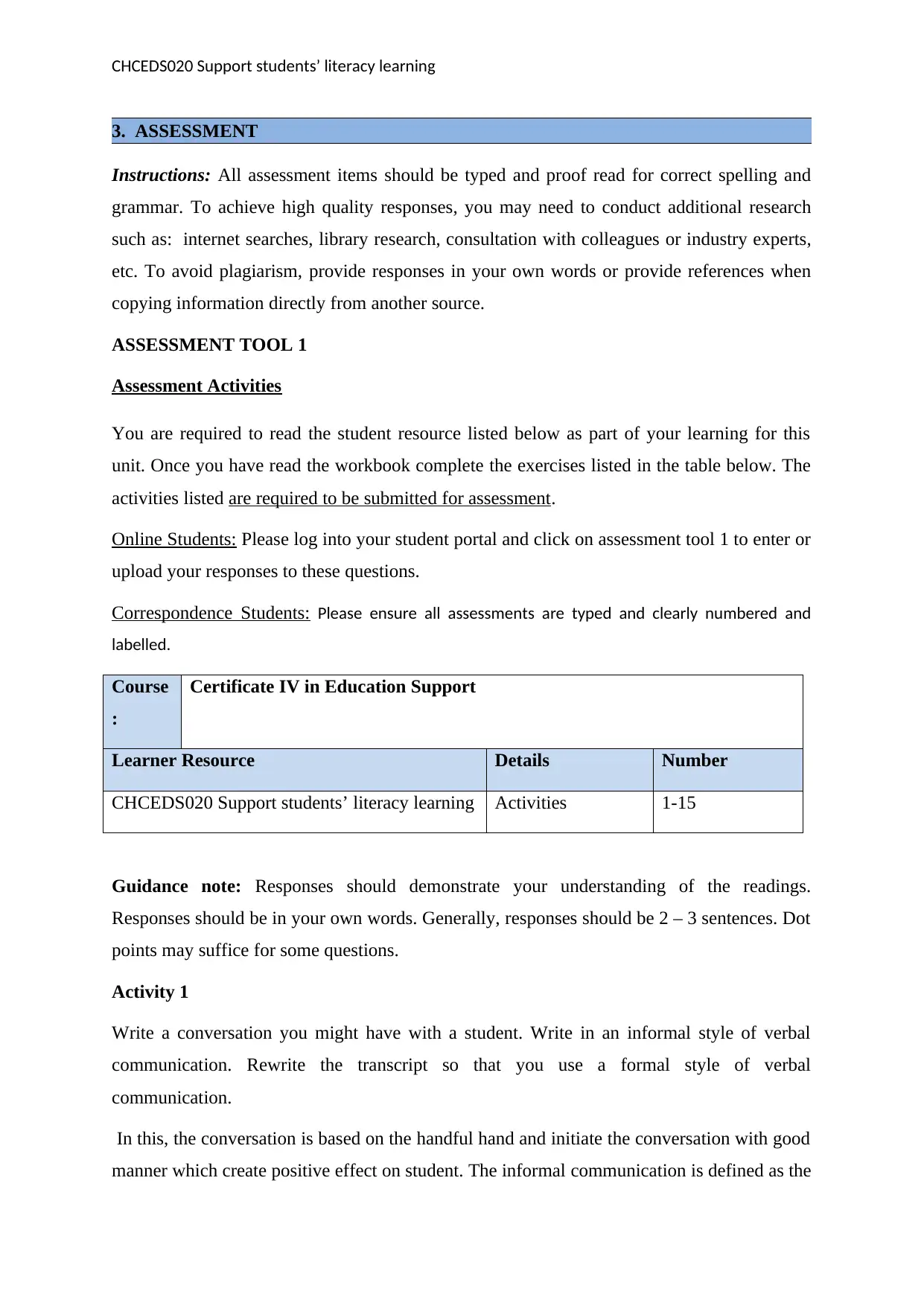
CHCEDS020 Support students’ literacy learning
3. ASSESSMENT
Instructions: All assessment items should be typed and proof read for correct spelling and
grammar. To achieve high quality responses, you may need to conduct additional research
such as: internet searches, library research, consultation with colleagues or industry experts,
etc. To avoid plagiarism, provide responses in your own words or provide references when
copying information directly from another source.
ASSESSMENT TOOL 1
Assessment Activities
You are required to read the student resource listed below as part of your learning for this
unit. Once you have read the workbook complete the exercises listed in the table below. The
activities listed are required to be submitted for assessment.
Online Students: Please log into your student portal and click on assessment tool 1 to enter or
upload your responses to these questions.
Correspondence Students: Please ensure all assessments are typed and clearly numbered and
labelled.
Course
:
Certificate IV in Education Support
Learner Resource Details Number
CHCEDS020 Support students’ literacy learning Activities 1-15
Guidance note: Responses should demonstrate your understanding of the readings.
Responses should be in your own words. Generally, responses should be 2 – 3 sentences. Dot
points may suffice for some questions.
Activity 1
Write a conversation you might have with a student. Write in an informal style of verbal
communication. Rewrite the transcript so that you use a formal style of verbal
communication.
In this, the conversation is based on the handful hand and initiate the conversation with good
manner which create positive effect on student. The informal communication is defined as the
3. ASSESSMENT
Instructions: All assessment items should be typed and proof read for correct spelling and
grammar. To achieve high quality responses, you may need to conduct additional research
such as: internet searches, library research, consultation with colleagues or industry experts,
etc. To avoid plagiarism, provide responses in your own words or provide references when
copying information directly from another source.
ASSESSMENT TOOL 1
Assessment Activities
You are required to read the student resource listed below as part of your learning for this
unit. Once you have read the workbook complete the exercises listed in the table below. The
activities listed are required to be submitted for assessment.
Online Students: Please log into your student portal and click on assessment tool 1 to enter or
upload your responses to these questions.
Correspondence Students: Please ensure all assessments are typed and clearly numbered and
labelled.
Course
:
Certificate IV in Education Support
Learner Resource Details Number
CHCEDS020 Support students’ literacy learning Activities 1-15
Guidance note: Responses should demonstrate your understanding of the readings.
Responses should be in your own words. Generally, responses should be 2 – 3 sentences. Dot
points may suffice for some questions.
Activity 1
Write a conversation you might have with a student. Write in an informal style of verbal
communication. Rewrite the transcript so that you use a formal style of verbal
communication.
In this, the conversation is based on the handful hand and initiate the conversation with good
manner which create positive effect on student. The informal communication is defined as the
Secure Best Marks with AI Grader
Need help grading? Try our AI Grader for instant feedback on your assignments.
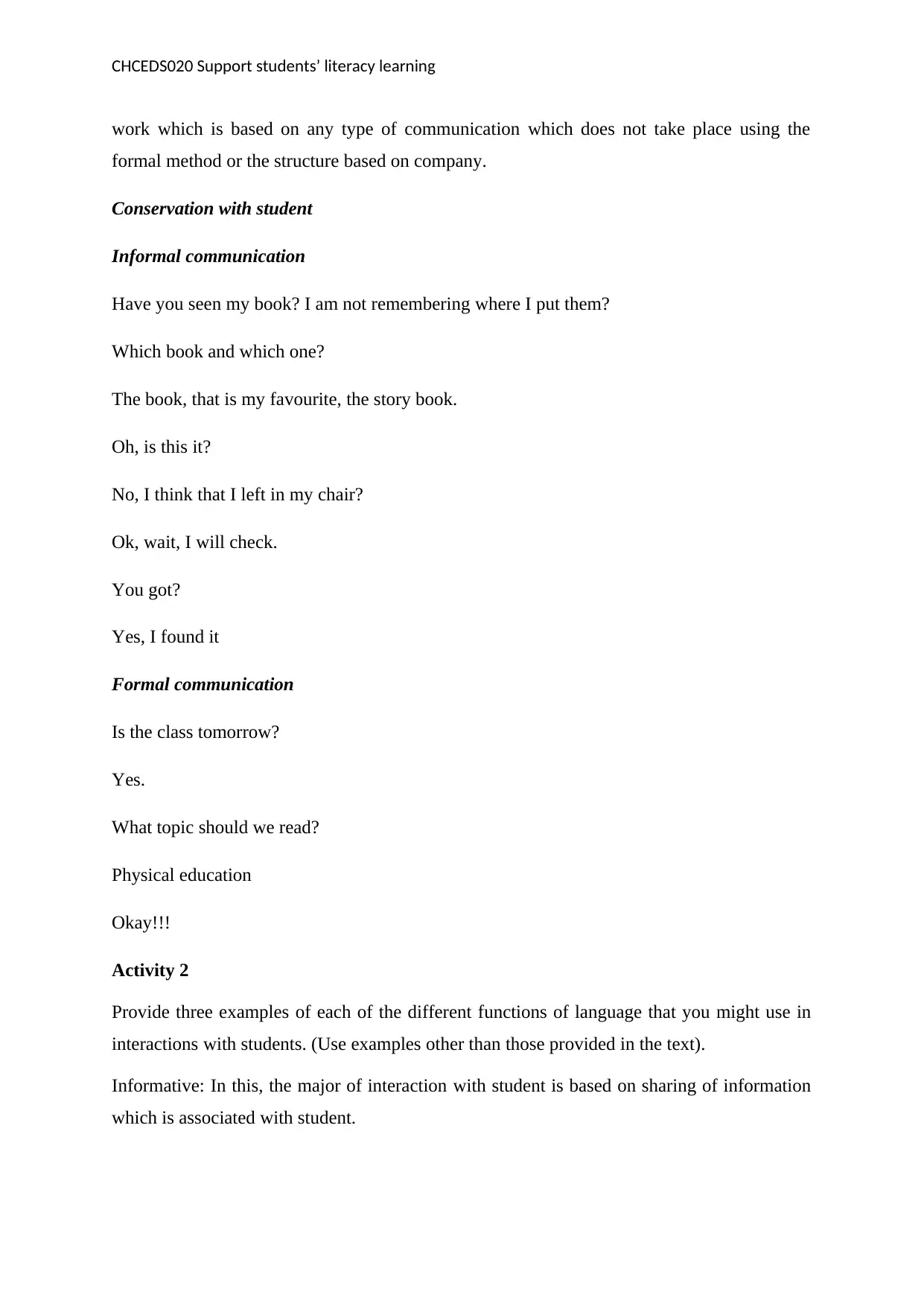
CHCEDS020 Support students’ literacy learning
work which is based on any type of communication which does not take place using the
formal method or the structure based on company.
Conservation with student
Informal communication
Have you seen my book? I am not remembering where I put them?
Which book and which one?
The book, that is my favourite, the story book.
Oh, is this it?
No, I think that I left in my chair?
Ok, wait, I will check.
You got?
Yes, I found it
Formal communication
Is the class tomorrow?
Yes.
What topic should we read?
Physical education
Okay!!!
Activity 2
Provide three examples of each of the different functions of language that you might use in
interactions with students. (Use examples other than those provided in the text).
Informative: In this, the major of interaction with student is based on sharing of information
which is associated with student.
work which is based on any type of communication which does not take place using the
formal method or the structure based on company.
Conservation with student
Informal communication
Have you seen my book? I am not remembering where I put them?
Which book and which one?
The book, that is my favourite, the story book.
Oh, is this it?
No, I think that I left in my chair?
Ok, wait, I will check.
You got?
Yes, I found it
Formal communication
Is the class tomorrow?
Yes.
What topic should we read?
Physical education
Okay!!!
Activity 2
Provide three examples of each of the different functions of language that you might use in
interactions with students. (Use examples other than those provided in the text).
Informative: In this, the major of interaction with student is based on sharing of information
which is associated with student.

CHCEDS020 Support students’ literacy learning
Expressive: The expressive behaviour is defined as the term which is used for the interaction
by using face expression, hand expression and other for making proper communication. In
this, the expression is usually providing an aspect which is based on student in order to share
the thought with the help of expression.
Directive language: The directive language usually carries helpful for the student to
understand because it contains verbal and nonverbal communication. A person uses his
language to various purpose which include express his feeling and used to ask for the help
and make them apologise.
Activity 3
Choose a child you work with or a child you know, such as a niece or nephew, or a friend’s
child. Monitor the child’s understanding and use of language through observation, listening
and conversation. Record your observations. What did you learn about the child’s spoken
language skills?
Child is making their understanding which is based on various pattern. The selected child for
the observation is 8-year-old. He is usually observed the thing with the help of
communication. In this, the verbal communication is more effective for the children make a
clear understanding. As per this, the child use expression and other form of communication
which help to provide quality of communication to others. Overall, he used to listen the
conversation is well manner that produce the sense of active listener. With this contrast, the
observation is recorded which help to elaborate about the child behaviour which indicate that
he is active listener and used to communicate with people in the effective way.
Expressive: The expressive behaviour is defined as the term which is used for the interaction
by using face expression, hand expression and other for making proper communication. In
this, the expression is usually providing an aspect which is based on student in order to share
the thought with the help of expression.
Directive language: The directive language usually carries helpful for the student to
understand because it contains verbal and nonverbal communication. A person uses his
language to various purpose which include express his feeling and used to ask for the help
and make them apologise.
Activity 3
Choose a child you work with or a child you know, such as a niece or nephew, or a friend’s
child. Monitor the child’s understanding and use of language through observation, listening
and conversation. Record your observations. What did you learn about the child’s spoken
language skills?
Child is making their understanding which is based on various pattern. The selected child for
the observation is 8-year-old. He is usually observed the thing with the help of
communication. In this, the verbal communication is more effective for the children make a
clear understanding. As per this, the child use expression and other form of communication
which help to provide quality of communication to others. Overall, he used to listen the
conversation is well manner that produce the sense of active listener. With this contrast, the
observation is recorded which help to elaborate about the child behaviour which indicate that
he is active listener and used to communicate with people in the effective way.
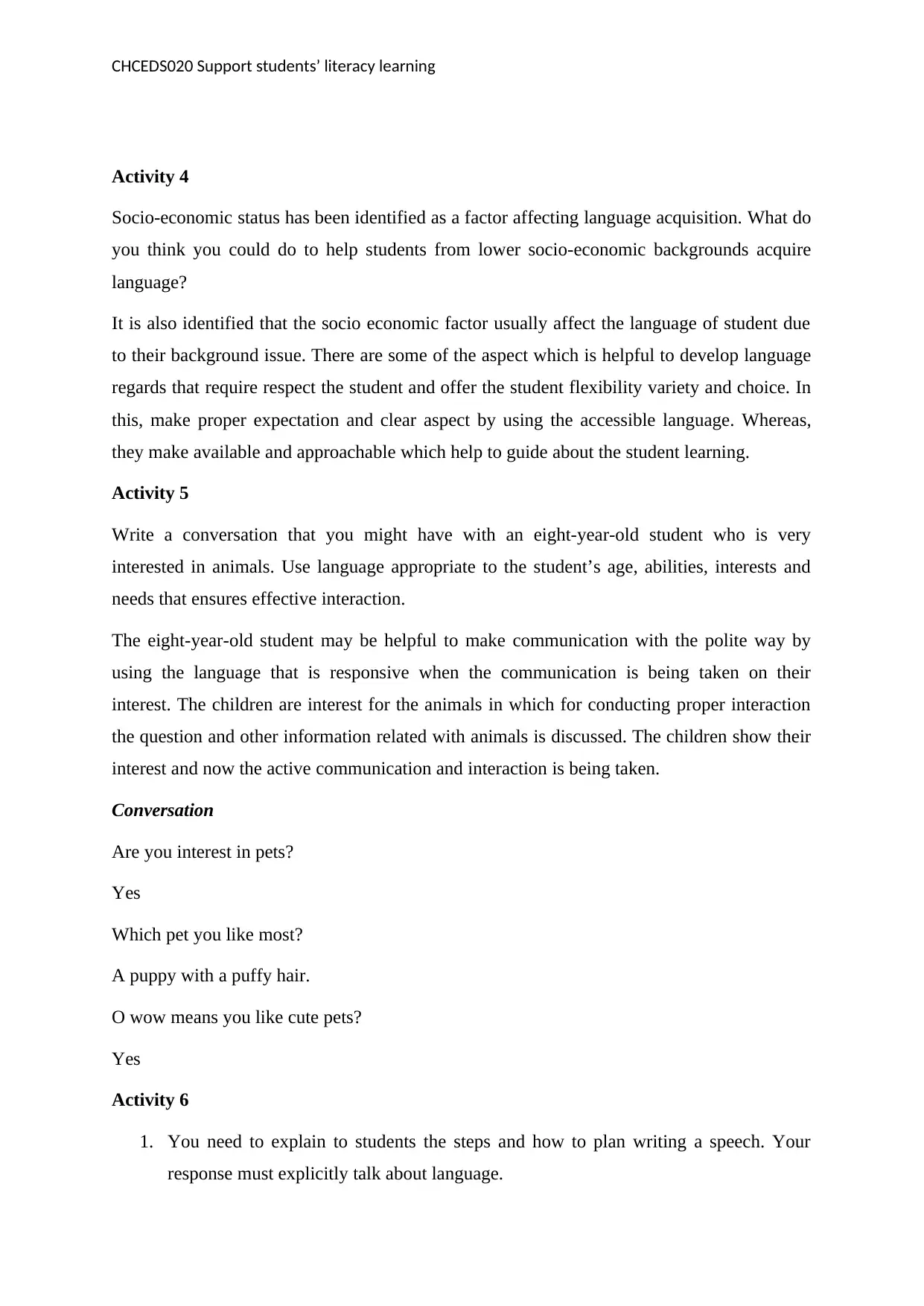
CHCEDS020 Support students’ literacy learning
Activity 4
Socio-economic status has been identified as a factor affecting language acquisition. What do
you think you could do to help students from lower socio-economic backgrounds acquire
language?
It is also identified that the socio economic factor usually affect the language of student due
to their background issue. There are some of the aspect which is helpful to develop language
regards that require respect the student and offer the student flexibility variety and choice. In
this, make proper expectation and clear aspect by using the accessible language. Whereas,
they make available and approachable which help to guide about the student learning.
Activity 5
Write a conversation that you might have with an eight-year-old student who is very
interested in animals. Use language appropriate to the student’s age, abilities, interests and
needs that ensures effective interaction.
The eight-year-old student may be helpful to make communication with the polite way by
using the language that is responsive when the communication is being taken on their
interest. The children are interest for the animals in which for conducting proper interaction
the question and other information related with animals is discussed. The children show their
interest and now the active communication and interaction is being taken.
Conversation
Are you interest in pets?
Yes
Which pet you like most?
A puppy with a puffy hair.
O wow means you like cute pets?
Yes
Activity 6
1. You need to explain to students the steps and how to plan writing a speech. Your
response must explicitly talk about language.
Activity 4
Socio-economic status has been identified as a factor affecting language acquisition. What do
you think you could do to help students from lower socio-economic backgrounds acquire
language?
It is also identified that the socio economic factor usually affect the language of student due
to their background issue. There are some of the aspect which is helpful to develop language
regards that require respect the student and offer the student flexibility variety and choice. In
this, make proper expectation and clear aspect by using the accessible language. Whereas,
they make available and approachable which help to guide about the student learning.
Activity 5
Write a conversation that you might have with an eight-year-old student who is very
interested in animals. Use language appropriate to the student’s age, abilities, interests and
needs that ensures effective interaction.
The eight-year-old student may be helpful to make communication with the polite way by
using the language that is responsive when the communication is being taken on their
interest. The children are interest for the animals in which for conducting proper interaction
the question and other information related with animals is discussed. The children show their
interest and now the active communication and interaction is being taken.
Conversation
Are you interest in pets?
Yes
Which pet you like most?
A puppy with a puffy hair.
O wow means you like cute pets?
Yes
Activity 6
1. You need to explain to students the steps and how to plan writing a speech. Your
response must explicitly talk about language.
Secure Best Marks with AI Grader
Need help grading? Try our AI Grader for instant feedback on your assignments.
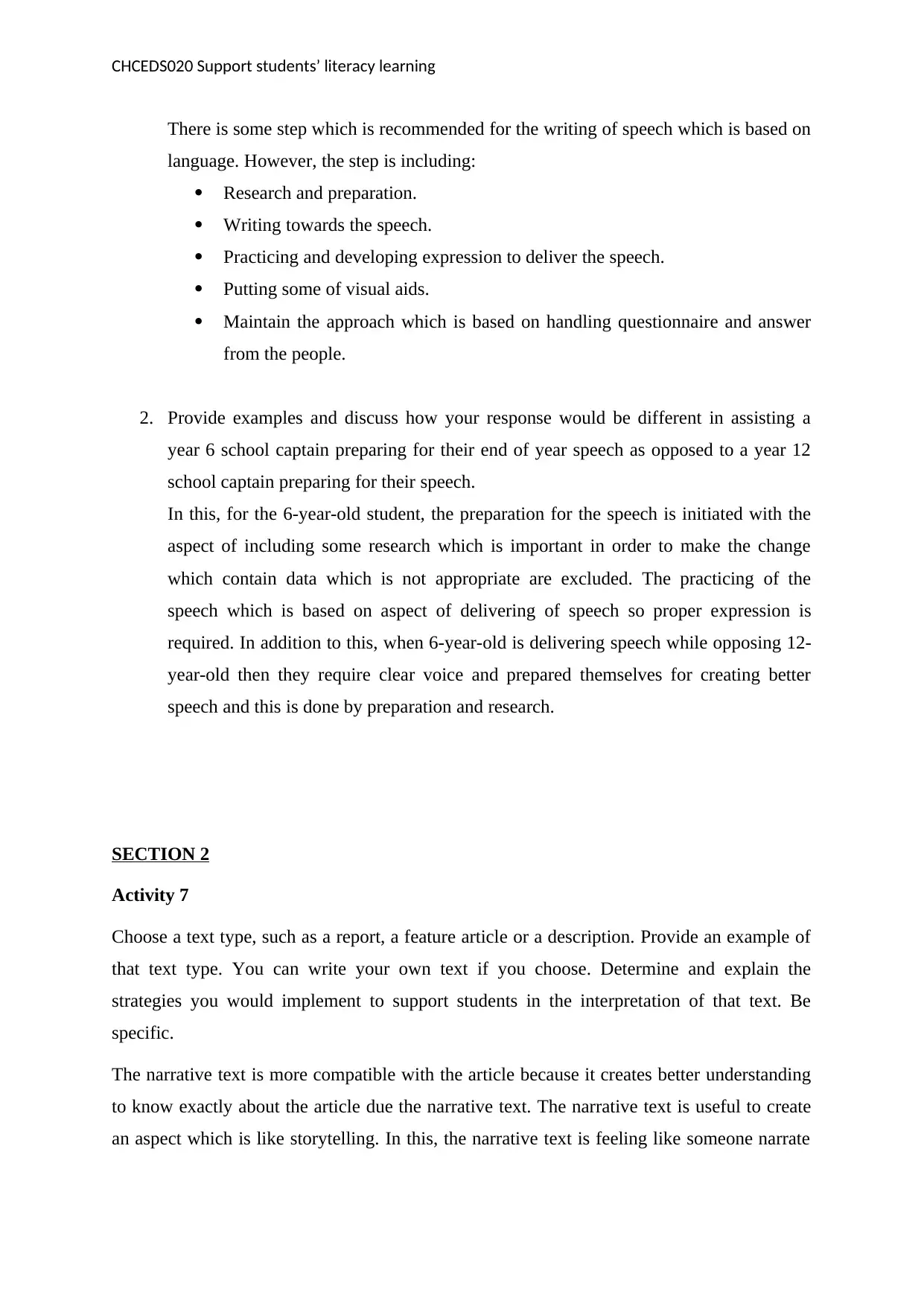
CHCEDS020 Support students’ literacy learning
There is some step which is recommended for the writing of speech which is based on
language. However, the step is including:
Research and preparation.
Writing towards the speech.
Practicing and developing expression to deliver the speech.
Putting some of visual aids.
Maintain the approach which is based on handling questionnaire and answer
from the people.
2. Provide examples and discuss how your response would be different in assisting a
year 6 school captain preparing for their end of year speech as opposed to a year 12
school captain preparing for their speech.
In this, for the 6-year-old student, the preparation for the speech is initiated with the
aspect of including some research which is important in order to make the change
which contain data which is not appropriate are excluded. The practicing of the
speech which is based on aspect of delivering of speech so proper expression is
required. In addition to this, when 6-year-old is delivering speech while opposing 12-
year-old then they require clear voice and prepared themselves for creating better
speech and this is done by preparation and research.
SECTION 2
Activity 7
Choose a text type, such as a report, a feature article or a description. Provide an example of
that text type. You can write your own text if you choose. Determine and explain the
strategies you would implement to support students in the interpretation of that text. Be
specific.
The narrative text is more compatible with the article because it creates better understanding
to know exactly about the article due the narrative text. The narrative text is useful to create
an aspect which is like storytelling. In this, the narrative text is feeling like someone narrate
There is some step which is recommended for the writing of speech which is based on
language. However, the step is including:
Research and preparation.
Writing towards the speech.
Practicing and developing expression to deliver the speech.
Putting some of visual aids.
Maintain the approach which is based on handling questionnaire and answer
from the people.
2. Provide examples and discuss how your response would be different in assisting a
year 6 school captain preparing for their end of year speech as opposed to a year 12
school captain preparing for their speech.
In this, for the 6-year-old student, the preparation for the speech is initiated with the
aspect of including some research which is important in order to make the change
which contain data which is not appropriate are excluded. The practicing of the
speech which is based on aspect of delivering of speech so proper expression is
required. In addition to this, when 6-year-old is delivering speech while opposing 12-
year-old then they require clear voice and prepared themselves for creating better
speech and this is done by preparation and research.
SECTION 2
Activity 7
Choose a text type, such as a report, a feature article or a description. Provide an example of
that text type. You can write your own text if you choose. Determine and explain the
strategies you would implement to support students in the interpretation of that text. Be
specific.
The narrative text is more compatible with the article because it creates better understanding
to know exactly about the article due the narrative text. The narrative text is useful to create
an aspect which is like storytelling. In this, the narrative text is feeling like someone narrate
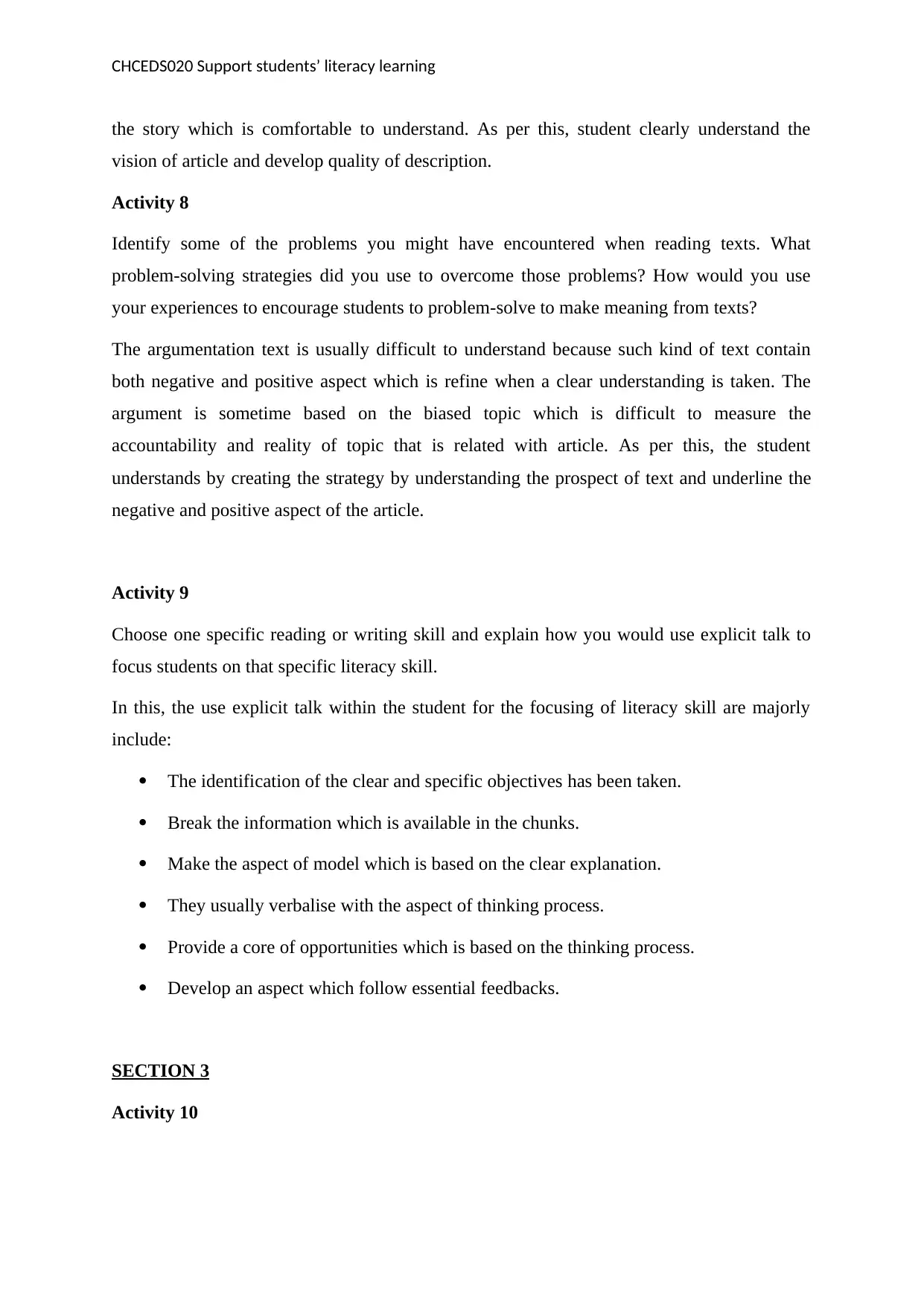
CHCEDS020 Support students’ literacy learning
the story which is comfortable to understand. As per this, student clearly understand the
vision of article and develop quality of description.
Activity 8
Identify some of the problems you might have encountered when reading texts. What
problem-solving strategies did you use to overcome those problems? How would you use
your experiences to encourage students to problem-solve to make meaning from texts?
The argumentation text is usually difficult to understand because such kind of text contain
both negative and positive aspect which is refine when a clear understanding is taken. The
argument is sometime based on the biased topic which is difficult to measure the
accountability and reality of topic that is related with article. As per this, the student
understands by creating the strategy by understanding the prospect of text and underline the
negative and positive aspect of the article.
Activity 9
Choose one specific reading or writing skill and explain how you would use explicit talk to
focus students on that specific literacy skill.
In this, the use explicit talk within the student for the focusing of literacy skill are majorly
include:
The identification of the clear and specific objectives has been taken.
Break the information which is available in the chunks.
Make the aspect of model which is based on the clear explanation.
They usually verbalise with the aspect of thinking process.
Provide a core of opportunities which is based on the thinking process.
Develop an aspect which follow essential feedbacks.
SECTION 3
Activity 10
the story which is comfortable to understand. As per this, student clearly understand the
vision of article and develop quality of description.
Activity 8
Identify some of the problems you might have encountered when reading texts. What
problem-solving strategies did you use to overcome those problems? How would you use
your experiences to encourage students to problem-solve to make meaning from texts?
The argumentation text is usually difficult to understand because such kind of text contain
both negative and positive aspect which is refine when a clear understanding is taken. The
argument is sometime based on the biased topic which is difficult to measure the
accountability and reality of topic that is related with article. As per this, the student
understands by creating the strategy by understanding the prospect of text and underline the
negative and positive aspect of the article.
Activity 9
Choose one specific reading or writing skill and explain how you would use explicit talk to
focus students on that specific literacy skill.
In this, the use explicit talk within the student for the focusing of literacy skill are majorly
include:
The identification of the clear and specific objectives has been taken.
Break the information which is available in the chunks.
Make the aspect of model which is based on the clear explanation.
They usually verbalise with the aspect of thinking process.
Provide a core of opportunities which is based on the thinking process.
Develop an aspect which follow essential feedbacks.
SECTION 3
Activity 10
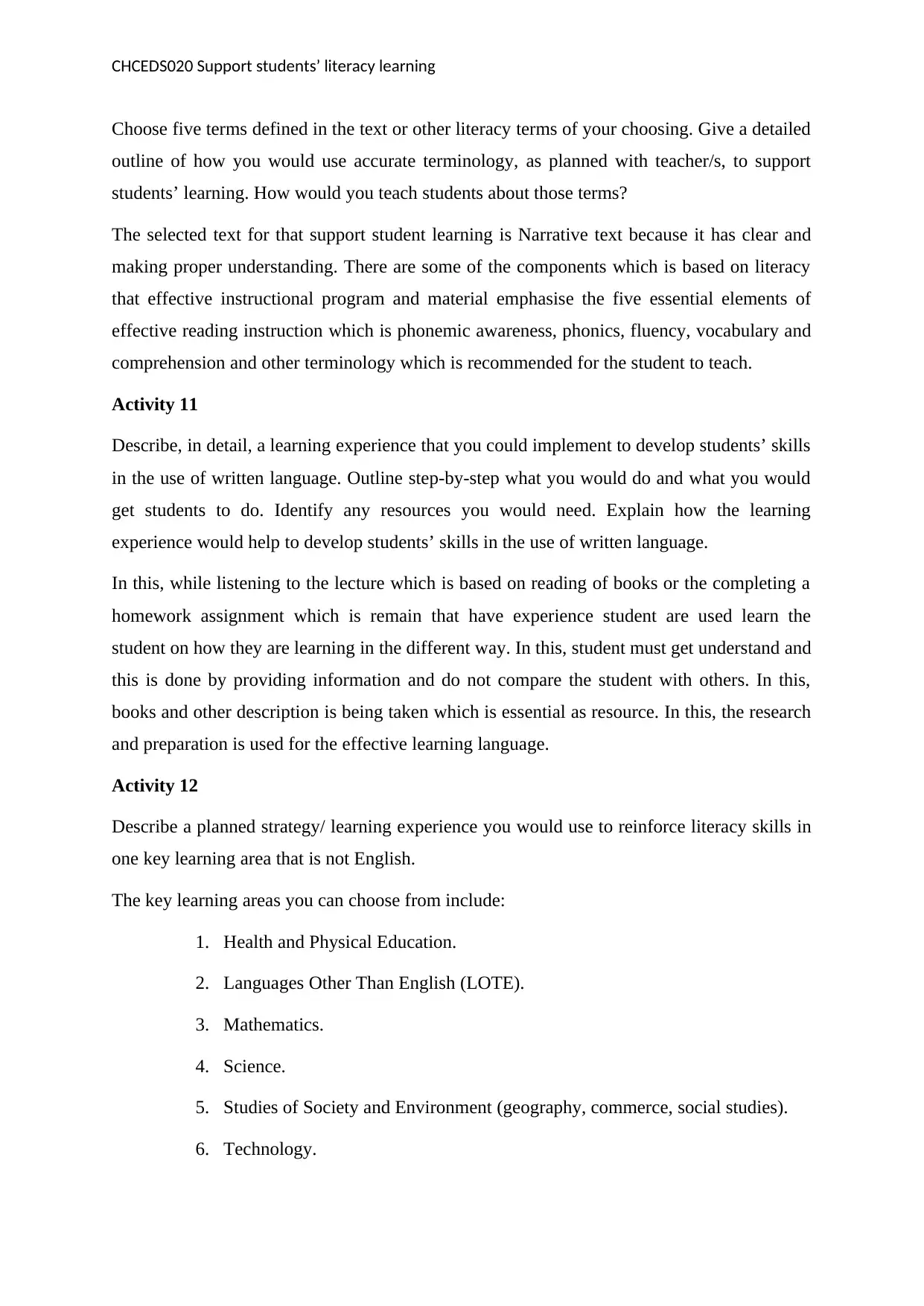
CHCEDS020 Support students’ literacy learning
Choose five terms defined in the text or other literacy terms of your choosing. Give a detailed
outline of how you would use accurate terminology, as planned with teacher/s, to support
students’ learning. How would you teach students about those terms?
The selected text for that support student learning is Narrative text because it has clear and
making proper understanding. There are some of the components which is based on literacy
that effective instructional program and material emphasise the five essential elements of
effective reading instruction which is phonemic awareness, phonics, fluency, vocabulary and
comprehension and other terminology which is recommended for the student to teach.
Activity 11
Describe, in detail, a learning experience that you could implement to develop students’ skills
in the use of written language. Outline step-by-step what you would do and what you would
get students to do. Identify any resources you would need. Explain how the learning
experience would help to develop students’ skills in the use of written language.
In this, while listening to the lecture which is based on reading of books or the completing a
homework assignment which is remain that have experience student are used learn the
student on how they are learning in the different way. In this, student must get understand and
this is done by providing information and do not compare the student with others. In this,
books and other description is being taken which is essential as resource. In this, the research
and preparation is used for the effective learning language.
Activity 12
Describe a planned strategy/ learning experience you would use to reinforce literacy skills in
one key learning area that is not English.
The key learning areas you can choose from include:
1. Health and Physical Education.
2. Languages Other Than English (LOTE).
3. Mathematics.
4. Science.
5. Studies of Society and Environment (geography, commerce, social studies).
6. Technology.
Choose five terms defined in the text or other literacy terms of your choosing. Give a detailed
outline of how you would use accurate terminology, as planned with teacher/s, to support
students’ learning. How would you teach students about those terms?
The selected text for that support student learning is Narrative text because it has clear and
making proper understanding. There are some of the components which is based on literacy
that effective instructional program and material emphasise the five essential elements of
effective reading instruction which is phonemic awareness, phonics, fluency, vocabulary and
comprehension and other terminology which is recommended for the student to teach.
Activity 11
Describe, in detail, a learning experience that you could implement to develop students’ skills
in the use of written language. Outline step-by-step what you would do and what you would
get students to do. Identify any resources you would need. Explain how the learning
experience would help to develop students’ skills in the use of written language.
In this, while listening to the lecture which is based on reading of books or the completing a
homework assignment which is remain that have experience student are used learn the
student on how they are learning in the different way. In this, student must get understand and
this is done by providing information and do not compare the student with others. In this,
books and other description is being taken which is essential as resource. In this, the research
and preparation is used for the effective learning language.
Activity 12
Describe a planned strategy/ learning experience you would use to reinforce literacy skills in
one key learning area that is not English.
The key learning areas you can choose from include:
1. Health and Physical Education.
2. Languages Other Than English (LOTE).
3. Mathematics.
4. Science.
5. Studies of Society and Environment (geography, commerce, social studies).
6. Technology.
Paraphrase This Document
Need a fresh take? Get an instant paraphrase of this document with our AI Paraphraser
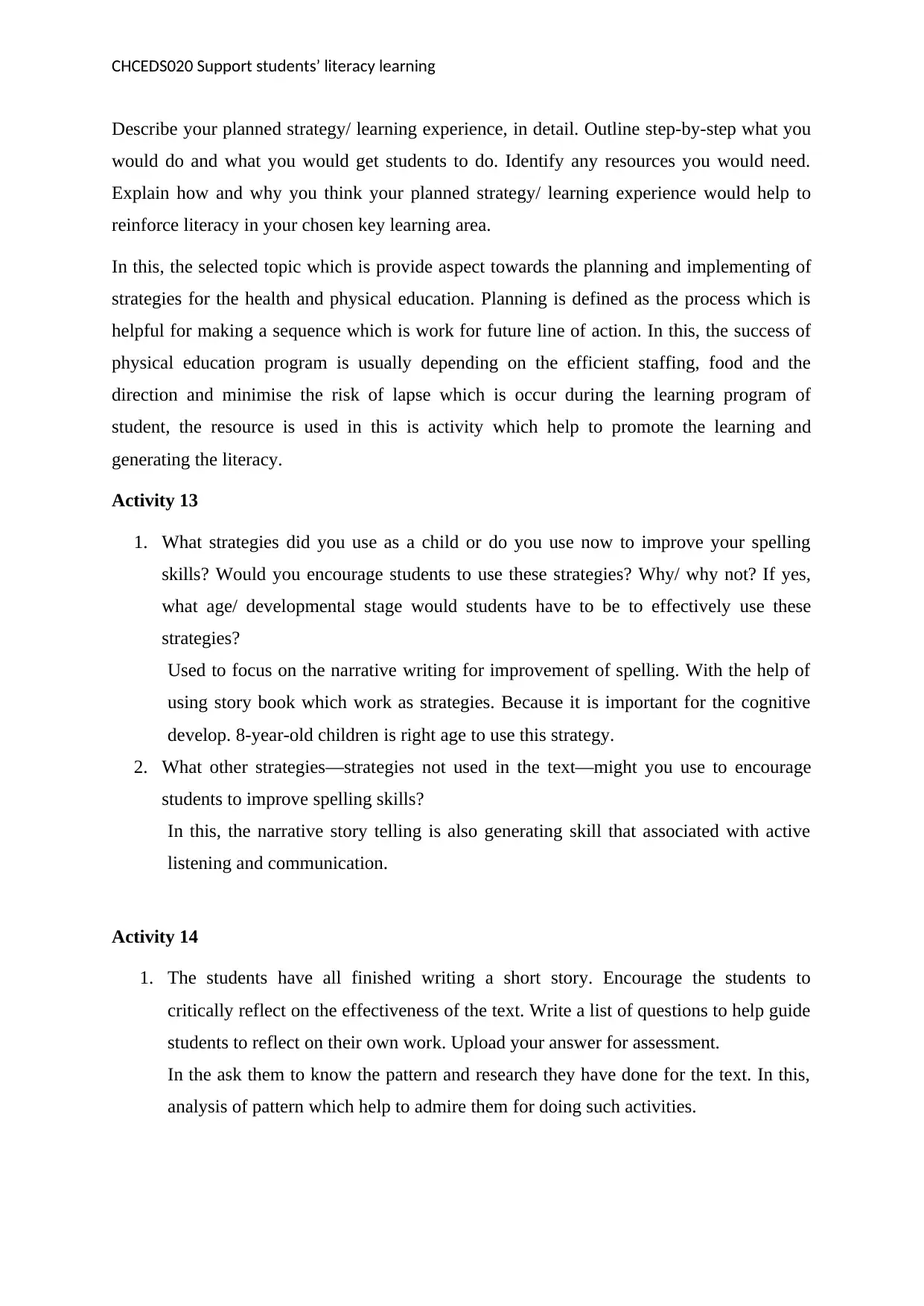
CHCEDS020 Support students’ literacy learning
Describe your planned strategy/ learning experience, in detail. Outline step-by-step what you
would do and what you would get students to do. Identify any resources you would need.
Explain how and why you think your planned strategy/ learning experience would help to
reinforce literacy in your chosen key learning area.
In this, the selected topic which is provide aspect towards the planning and implementing of
strategies for the health and physical education. Planning is defined as the process which is
helpful for making a sequence which is work for future line of action. In this, the success of
physical education program is usually depending on the efficient staffing, food and the
direction and minimise the risk of lapse which is occur during the learning program of
student, the resource is used in this is activity which help to promote the learning and
generating the literacy.
Activity 13
1. What strategies did you use as a child or do you use now to improve your spelling
skills? Would you encourage students to use these strategies? Why/ why not? If yes,
what age/ developmental stage would students have to be to effectively use these
strategies?
Used to focus on the narrative writing for improvement of spelling. With the help of
using story book which work as strategies. Because it is important for the cognitive
develop. 8-year-old children is right age to use this strategy.
2. What other strategies—strategies not used in the text—might you use to encourage
students to improve spelling skills?
In this, the narrative story telling is also generating skill that associated with active
listening and communication.
Activity 14
1. The students have all finished writing a short story. Encourage the students to
critically reflect on the effectiveness of the text. Write a list of questions to help guide
students to reflect on their own work. Upload your answer for assessment.
In the ask them to know the pattern and research they have done for the text. In this,
analysis of pattern which help to admire them for doing such activities.
Describe your planned strategy/ learning experience, in detail. Outline step-by-step what you
would do and what you would get students to do. Identify any resources you would need.
Explain how and why you think your planned strategy/ learning experience would help to
reinforce literacy in your chosen key learning area.
In this, the selected topic which is provide aspect towards the planning and implementing of
strategies for the health and physical education. Planning is defined as the process which is
helpful for making a sequence which is work for future line of action. In this, the success of
physical education program is usually depending on the efficient staffing, food and the
direction and minimise the risk of lapse which is occur during the learning program of
student, the resource is used in this is activity which help to promote the learning and
generating the literacy.
Activity 13
1. What strategies did you use as a child or do you use now to improve your spelling
skills? Would you encourage students to use these strategies? Why/ why not? If yes,
what age/ developmental stage would students have to be to effectively use these
strategies?
Used to focus on the narrative writing for improvement of spelling. With the help of
using story book which work as strategies. Because it is important for the cognitive
develop. 8-year-old children is right age to use this strategy.
2. What other strategies—strategies not used in the text—might you use to encourage
students to improve spelling skills?
In this, the narrative story telling is also generating skill that associated with active
listening and communication.
Activity 14
1. The students have all finished writing a short story. Encourage the students to
critically reflect on the effectiveness of the text. Write a list of questions to help guide
students to reflect on their own work. Upload your answer for assessment.
In the ask them to know the pattern and research they have done for the text. In this,
analysis of pattern which help to admire them for doing such activities.
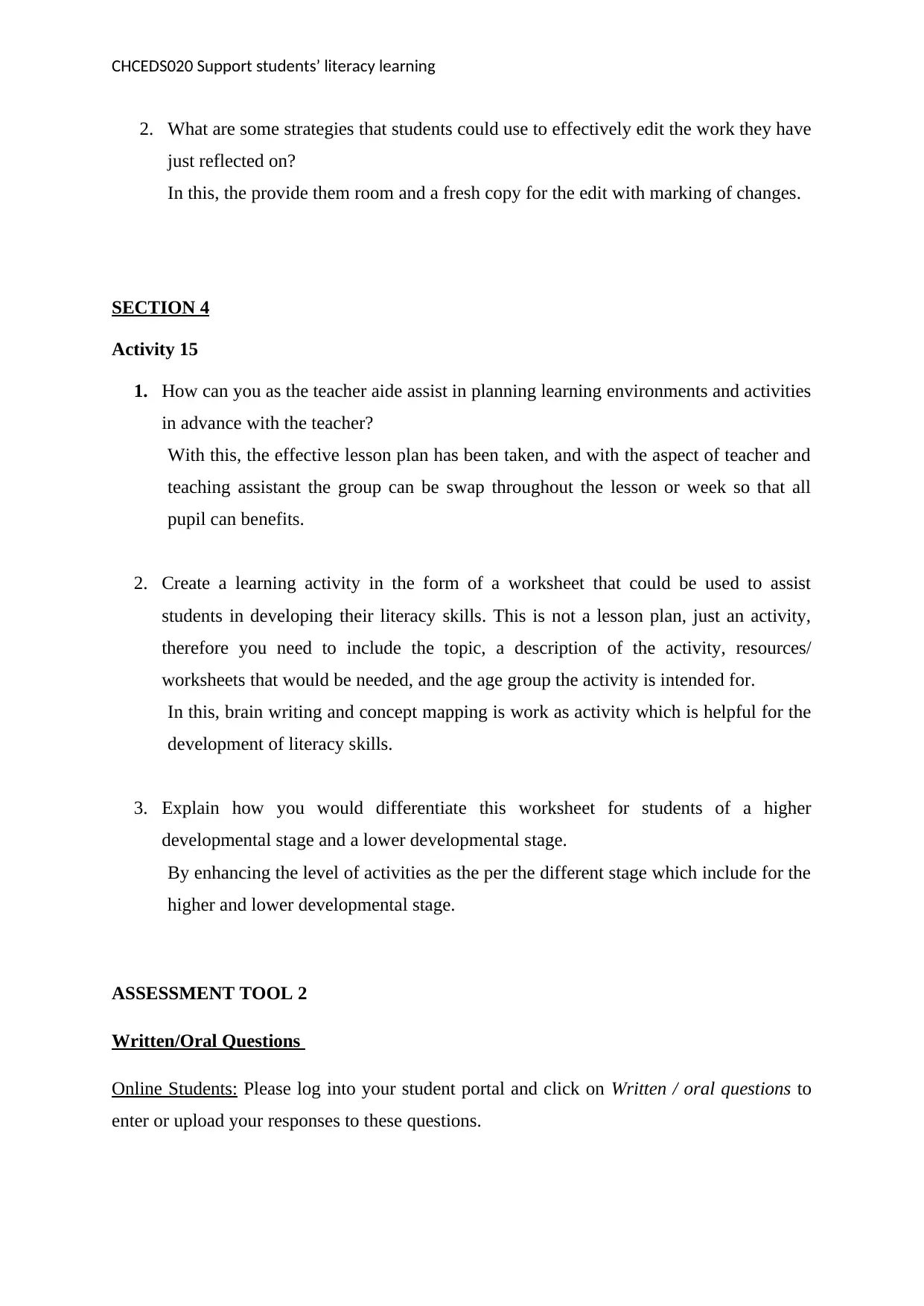
CHCEDS020 Support students’ literacy learning
2. What are some strategies that students could use to effectively edit the work they have
just reflected on?
In this, the provide them room and a fresh copy for the edit with marking of changes.
SECTION 4
Activity 15
1. How can you as the teacher aide assist in planning learning environments and activities
in advance with the teacher?
With this, the effective lesson plan has been taken, and with the aspect of teacher and
teaching assistant the group can be swap throughout the lesson or week so that all
pupil can benefits.
2. Create a learning activity in the form of a worksheet that could be used to assist
students in developing their literacy skills. This is not a lesson plan, just an activity,
therefore you need to include the topic, a description of the activity, resources/
worksheets that would be needed, and the age group the activity is intended for.
In this, brain writing and concept mapping is work as activity which is helpful for the
development of literacy skills.
3. Explain how you would differentiate this worksheet for students of a higher
developmental stage and a lower developmental stage.
By enhancing the level of activities as the per the different stage which include for the
higher and lower developmental stage.
ASSESSMENT TOOL 2
Written/Oral Questions
Online Students: Please log into your student portal and click on Written / oral questions to
enter or upload your responses to these questions.
2. What are some strategies that students could use to effectively edit the work they have
just reflected on?
In this, the provide them room and a fresh copy for the edit with marking of changes.
SECTION 4
Activity 15
1. How can you as the teacher aide assist in planning learning environments and activities
in advance with the teacher?
With this, the effective lesson plan has been taken, and with the aspect of teacher and
teaching assistant the group can be swap throughout the lesson or week so that all
pupil can benefits.
2. Create a learning activity in the form of a worksheet that could be used to assist
students in developing their literacy skills. This is not a lesson plan, just an activity,
therefore you need to include the topic, a description of the activity, resources/
worksheets that would be needed, and the age group the activity is intended for.
In this, brain writing and concept mapping is work as activity which is helpful for the
development of literacy skills.
3. Explain how you would differentiate this worksheet for students of a higher
developmental stage and a lower developmental stage.
By enhancing the level of activities as the per the different stage which include for the
higher and lower developmental stage.
ASSESSMENT TOOL 2
Written/Oral Questions
Online Students: Please log into your student portal and click on Written / oral questions to
enter or upload your responses to these questions.
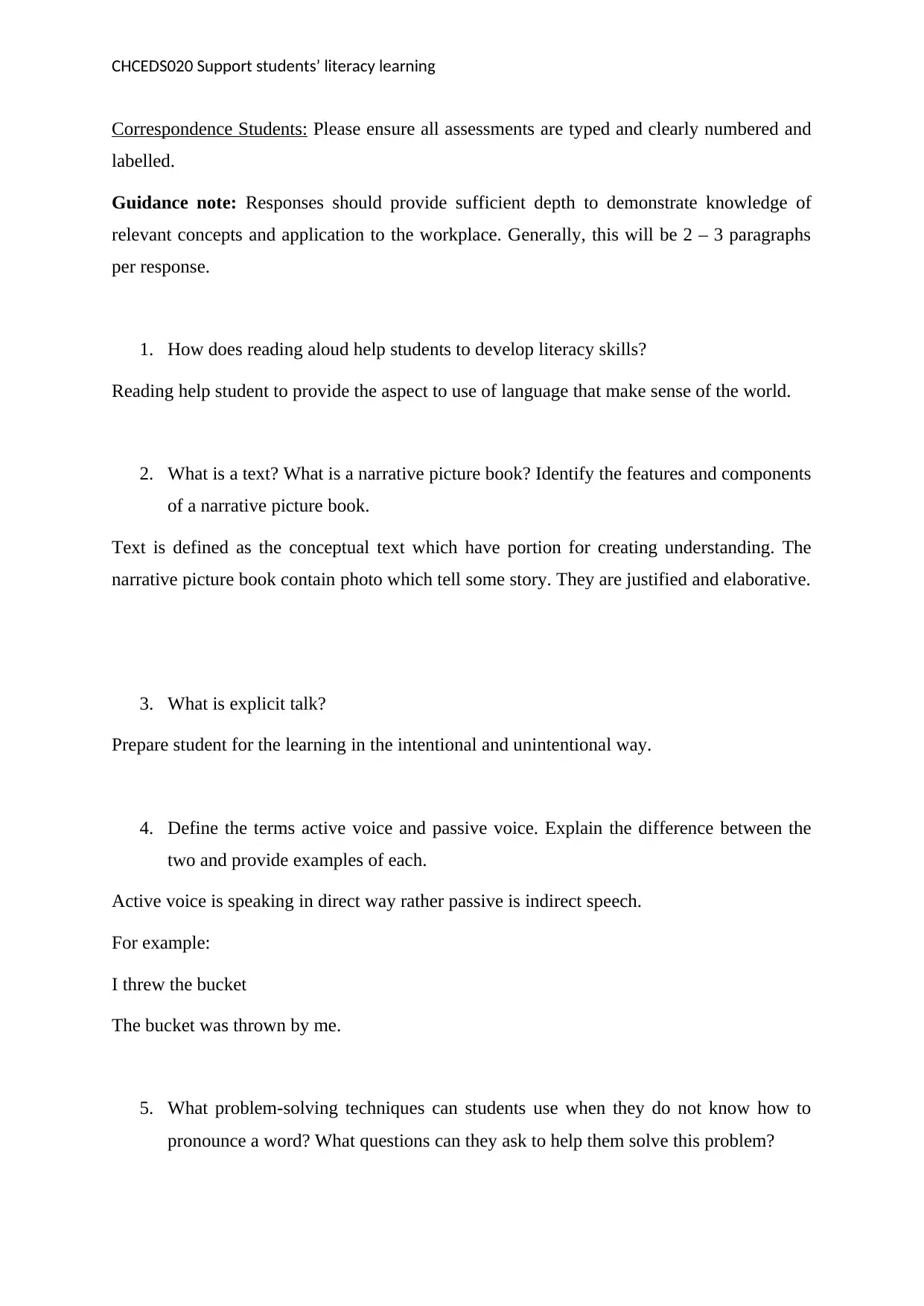
CHCEDS020 Support students’ literacy learning
Correspondence Students: Please ensure all assessments are typed and clearly numbered and
labelled.
Guidance note: Responses should provide sufficient depth to demonstrate knowledge of
relevant concepts and application to the workplace. Generally, this will be 2 – 3 paragraphs
per response.
1. How does reading aloud help students to develop literacy skills?
Reading help student to provide the aspect to use of language that make sense of the world.
2. What is a text? What is a narrative picture book? Identify the features and components
of a narrative picture book.
Text is defined as the conceptual text which have portion for creating understanding. The
narrative picture book contain photo which tell some story. They are justified and elaborative.
3. What is explicit talk?
Prepare student for the learning in the intentional and unintentional way.
4. Define the terms active voice and passive voice. Explain the difference between the
two and provide examples of each.
Active voice is speaking in direct way rather passive is indirect speech.
For example:
I threw the bucket
The bucket was thrown by me.
5. What problem-solving techniques can students use when they do not know how to
pronounce a word? What questions can they ask to help them solve this problem?
Correspondence Students: Please ensure all assessments are typed and clearly numbered and
labelled.
Guidance note: Responses should provide sufficient depth to demonstrate knowledge of
relevant concepts and application to the workplace. Generally, this will be 2 – 3 paragraphs
per response.
1. How does reading aloud help students to develop literacy skills?
Reading help student to provide the aspect to use of language that make sense of the world.
2. What is a text? What is a narrative picture book? Identify the features and components
of a narrative picture book.
Text is defined as the conceptual text which have portion for creating understanding. The
narrative picture book contain photo which tell some story. They are justified and elaborative.
3. What is explicit talk?
Prepare student for the learning in the intentional and unintentional way.
4. Define the terms active voice and passive voice. Explain the difference between the
two and provide examples of each.
Active voice is speaking in direct way rather passive is indirect speech.
For example:
I threw the bucket
The bucket was thrown by me.
5. What problem-solving techniques can students use when they do not know how to
pronounce a word? What questions can they ask to help them solve this problem?
Secure Best Marks with AI Grader
Need help grading? Try our AI Grader for instant feedback on your assignments.
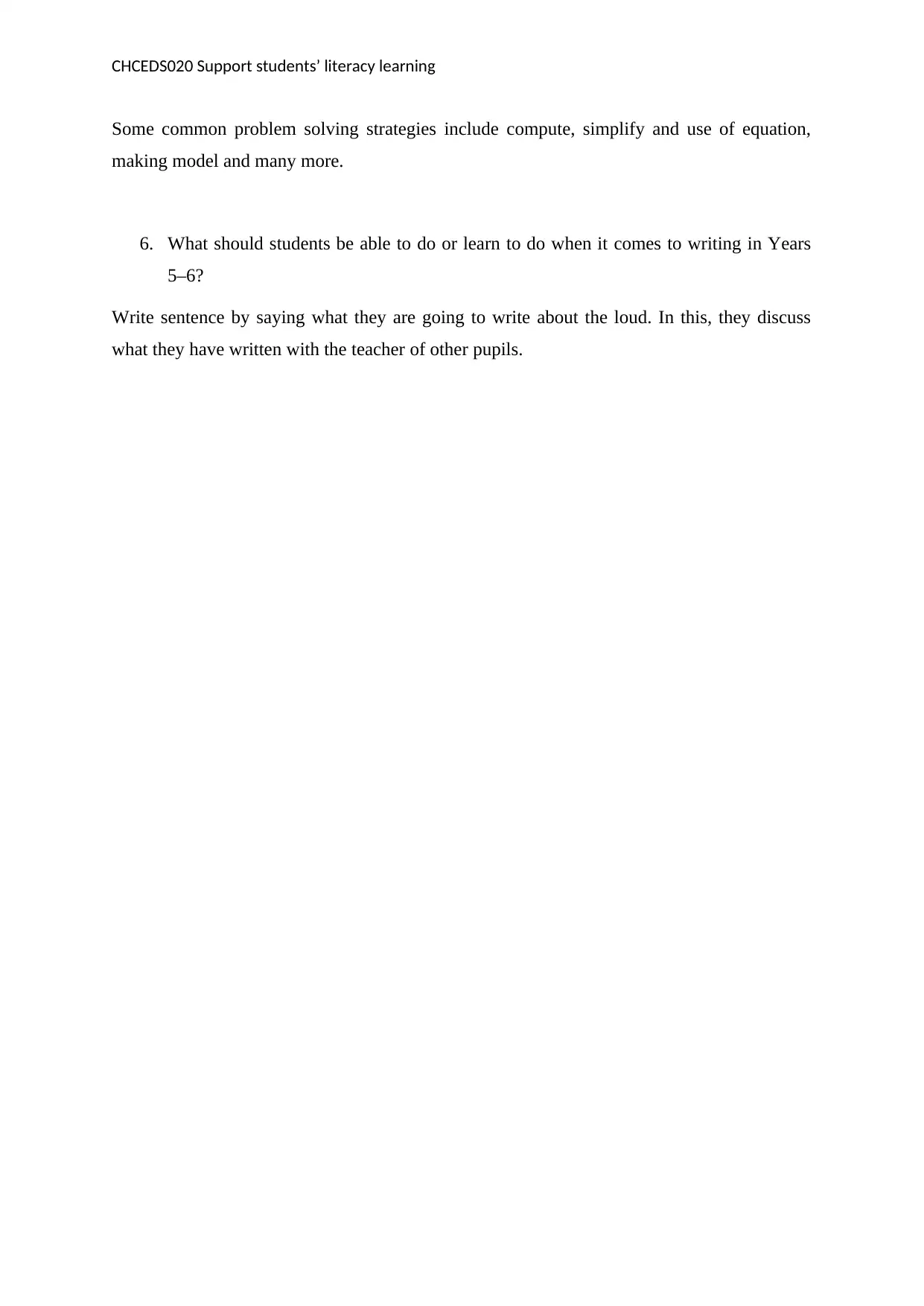
CHCEDS020 Support students’ literacy learning
Some common problem solving strategies include compute, simplify and use of equation,
making model and many more.
6. What should students be able to do or learn to do when it comes to writing in Years
5–6?
Write sentence by saying what they are going to write about the loud. In this, they discuss
what they have written with the teacher of other pupils.
Some common problem solving strategies include compute, simplify and use of equation,
making model and many more.
6. What should students be able to do or learn to do when it comes to writing in Years
5–6?
Write sentence by saying what they are going to write about the loud. In this, they discuss
what they have written with the teacher of other pupils.
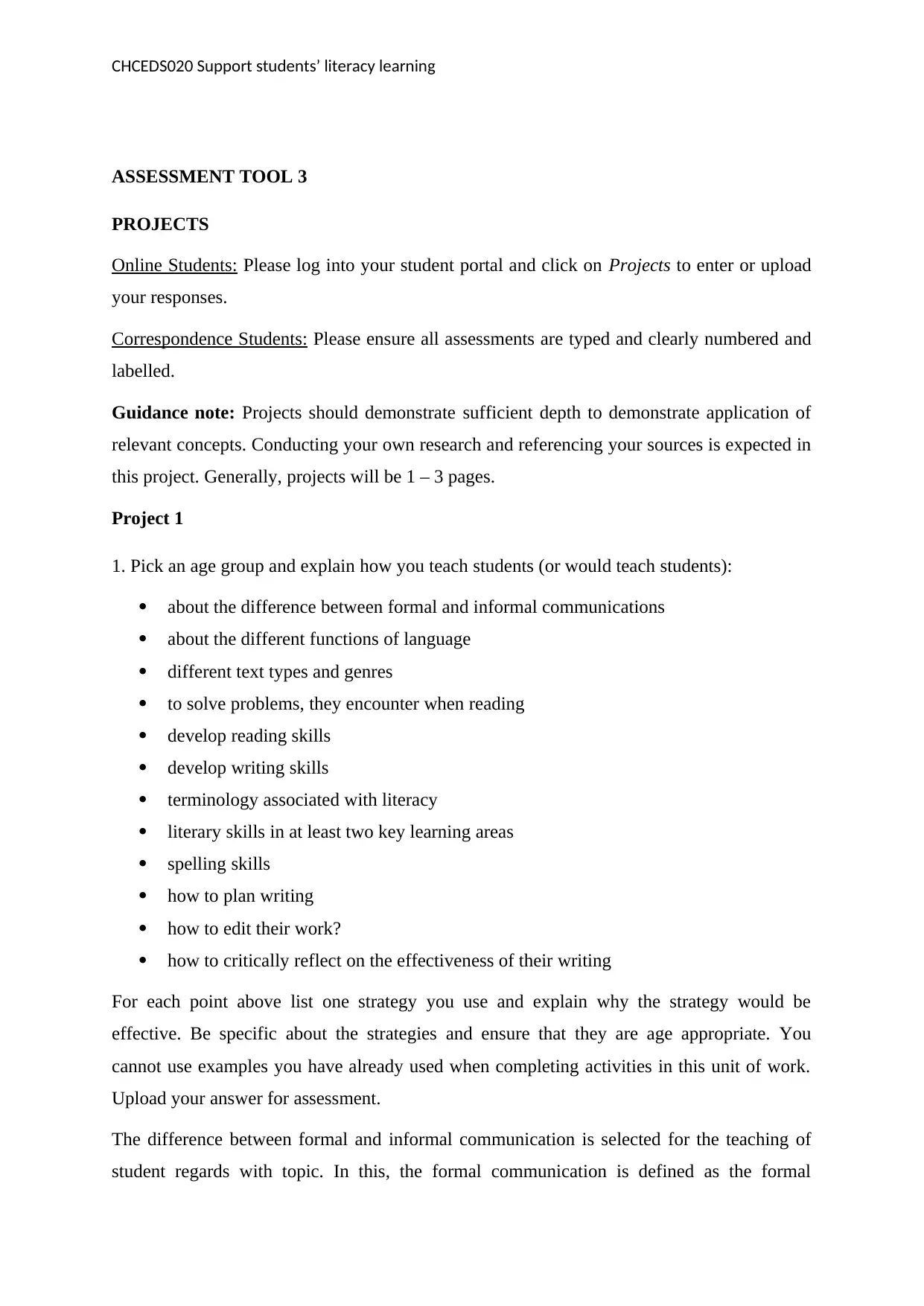
CHCEDS020 Support students’ literacy learning
ASSESSMENT TOOL 3
PROJECTS
Online Students: Please log into your student portal and click on Projects to enter or upload
your responses.
Correspondence Students: Please ensure all assessments are typed and clearly numbered and
labelled.
Guidance note: Projects should demonstrate sufficient depth to demonstrate application of
relevant concepts. Conducting your own research and referencing your sources is expected in
this project. Generally, projects will be 1 – 3 pages.
Project 1
1. Pick an age group and explain how you teach students (or would teach students):
about the difference between formal and informal communications
about the different functions of language
different text types and genres
to solve problems, they encounter when reading
develop reading skills
develop writing skills
terminology associated with literacy
literary skills in at least two key learning areas
spelling skills
how to plan writing
how to edit their work?
how to critically reflect on the effectiveness of their writing
For each point above list one strategy you use and explain why the strategy would be
effective. Be specific about the strategies and ensure that they are age appropriate. You
cannot use examples you have already used when completing activities in this unit of work.
Upload your answer for assessment.
The difference between formal and informal communication is selected for the teaching of
student regards with topic. In this, the formal communication is defined as the formal
ASSESSMENT TOOL 3
PROJECTS
Online Students: Please log into your student portal and click on Projects to enter or upload
your responses.
Correspondence Students: Please ensure all assessments are typed and clearly numbered and
labelled.
Guidance note: Projects should demonstrate sufficient depth to demonstrate application of
relevant concepts. Conducting your own research and referencing your sources is expected in
this project. Generally, projects will be 1 – 3 pages.
Project 1
1. Pick an age group and explain how you teach students (or would teach students):
about the difference between formal and informal communications
about the different functions of language
different text types and genres
to solve problems, they encounter when reading
develop reading skills
develop writing skills
terminology associated with literacy
literary skills in at least two key learning areas
spelling skills
how to plan writing
how to edit their work?
how to critically reflect on the effectiveness of their writing
For each point above list one strategy you use and explain why the strategy would be
effective. Be specific about the strategies and ensure that they are age appropriate. You
cannot use examples you have already used when completing activities in this unit of work.
Upload your answer for assessment.
The difference between formal and informal communication is selected for the teaching of
student regards with topic. In this, the formal communication is defined as the formal
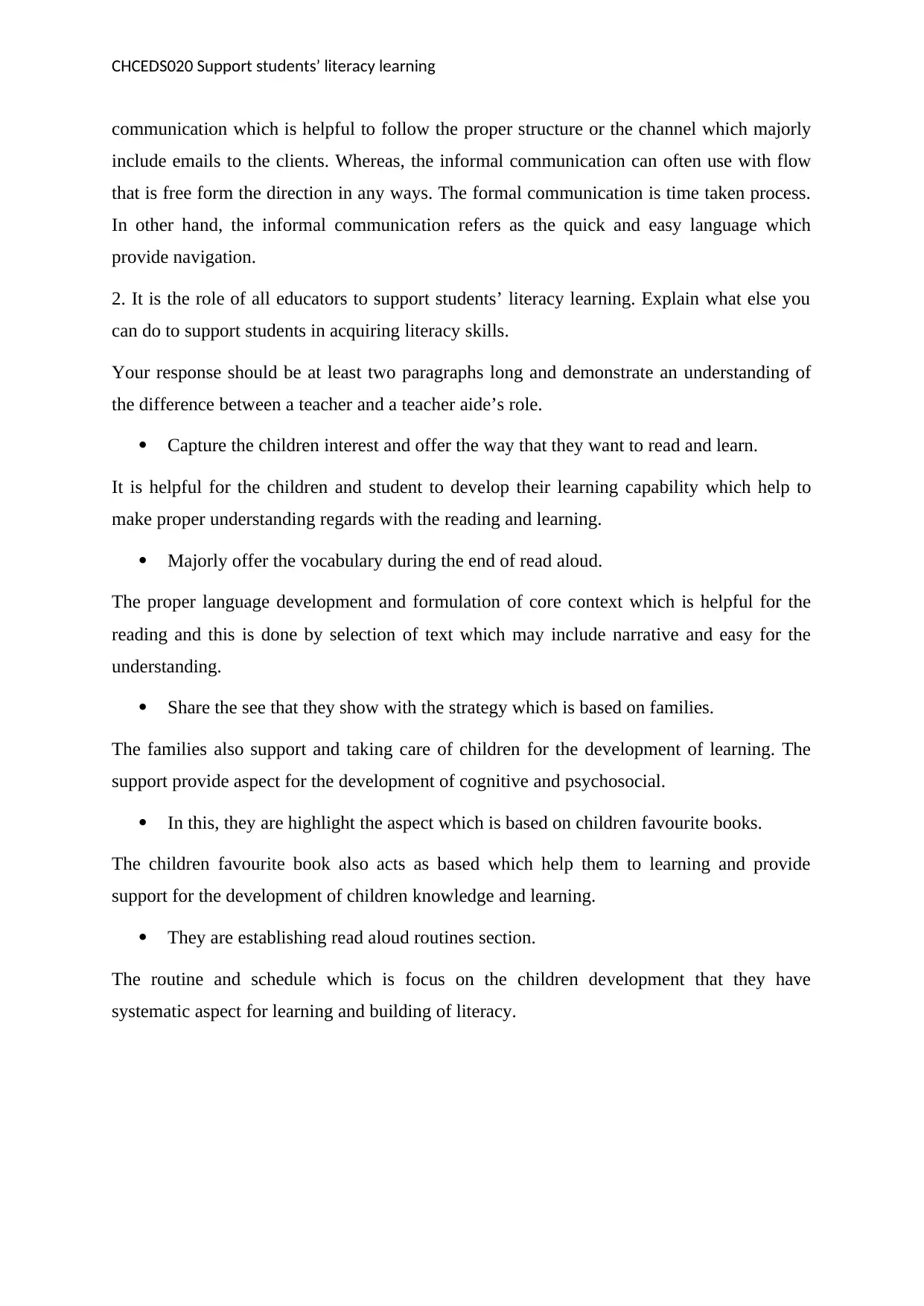
CHCEDS020 Support students’ literacy learning
communication which is helpful to follow the proper structure or the channel which majorly
include emails to the clients. Whereas, the informal communication can often use with flow
that is free form the direction in any ways. The formal communication is time taken process.
In other hand, the informal communication refers as the quick and easy language which
provide navigation.
2. It is the role of all educators to support students’ literacy learning. Explain what else you
can do to support students in acquiring literacy skills.
Your response should be at least two paragraphs long and demonstrate an understanding of
the difference between a teacher and a teacher aide’s role.
Capture the children interest and offer the way that they want to read and learn.
It is helpful for the children and student to develop their learning capability which help to
make proper understanding regards with the reading and learning.
Majorly offer the vocabulary during the end of read aloud.
The proper language development and formulation of core context which is helpful for the
reading and this is done by selection of text which may include narrative and easy for the
understanding.
Share the see that they show with the strategy which is based on families.
The families also support and taking care of children for the development of learning. The
support provide aspect for the development of cognitive and psychosocial.
In this, they are highlight the aspect which is based on children favourite books.
The children favourite book also acts as based which help them to learning and provide
support for the development of children knowledge and learning.
They are establishing read aloud routines section.
The routine and schedule which is focus on the children development that they have
systematic aspect for learning and building of literacy.
communication which is helpful to follow the proper structure or the channel which majorly
include emails to the clients. Whereas, the informal communication can often use with flow
that is free form the direction in any ways. The formal communication is time taken process.
In other hand, the informal communication refers as the quick and easy language which
provide navigation.
2. It is the role of all educators to support students’ literacy learning. Explain what else you
can do to support students in acquiring literacy skills.
Your response should be at least two paragraphs long and demonstrate an understanding of
the difference between a teacher and a teacher aide’s role.
Capture the children interest and offer the way that they want to read and learn.
It is helpful for the children and student to develop their learning capability which help to
make proper understanding regards with the reading and learning.
Majorly offer the vocabulary during the end of read aloud.
The proper language development and formulation of core context which is helpful for the
reading and this is done by selection of text which may include narrative and easy for the
understanding.
Share the see that they show with the strategy which is based on families.
The families also support and taking care of children for the development of learning. The
support provide aspect for the development of cognitive and psychosocial.
In this, they are highlight the aspect which is based on children favourite books.
The children favourite book also acts as based which help them to learning and provide
support for the development of children knowledge and learning.
They are establishing read aloud routines section.
The routine and schedule which is focus on the children development that they have
systematic aspect for learning and building of literacy.
Paraphrase This Document
Need a fresh take? Get an instant paraphrase of this document with our AI Paraphraser
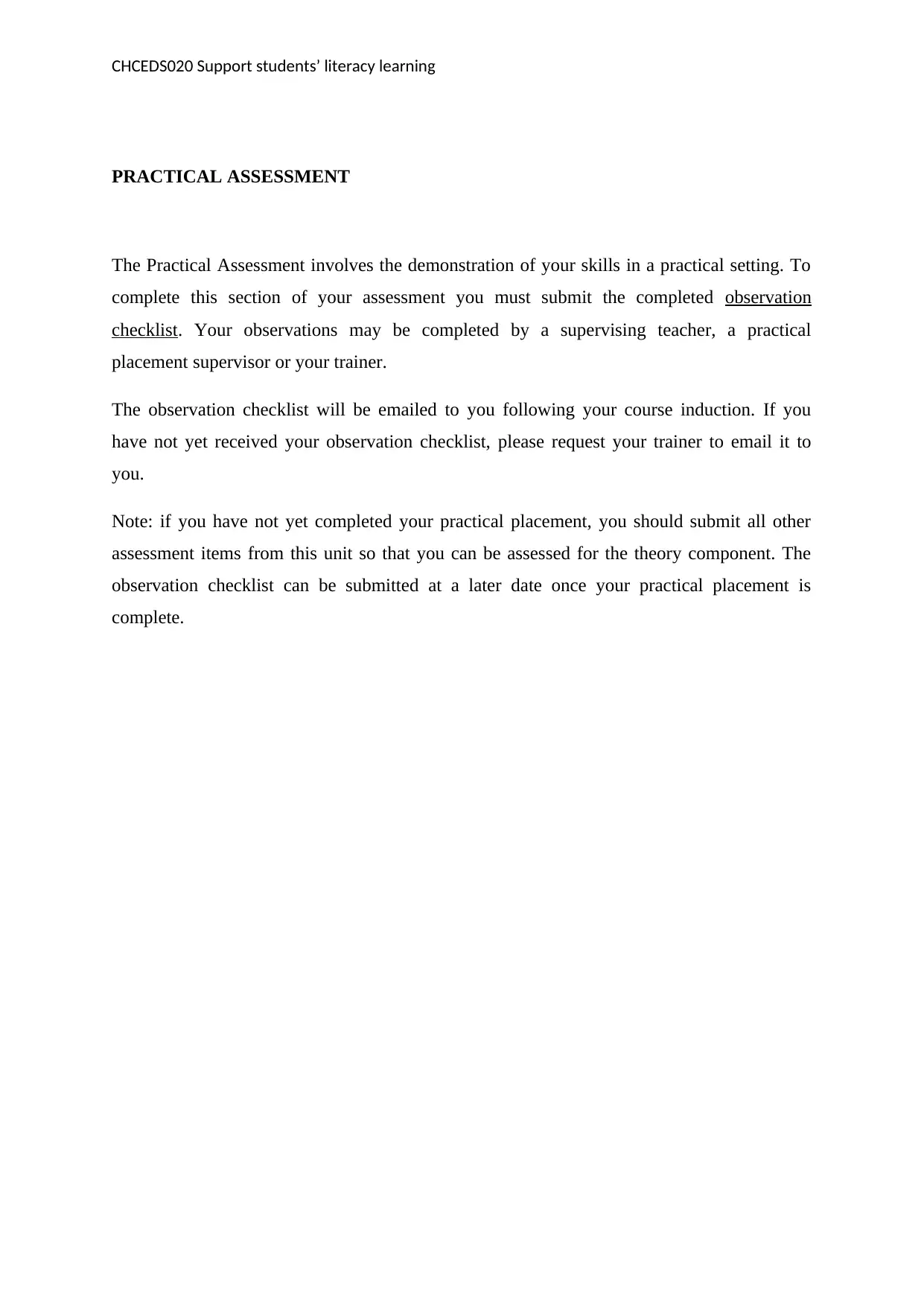
CHCEDS020 Support students’ literacy learning
PRACTICAL ASSESSMENT
The Practical Assessment involves the demonstration of your skills in a practical setting. To
complete this section of your assessment you must submit the completed observation
checklist. Your observations may be completed by a supervising teacher, a practical
placement supervisor or your trainer.
The observation checklist will be emailed to you following your course induction. If you
have not yet received your observation checklist, please request your trainer to email it to
you.
Note: if you have not yet completed your practical placement, you should submit all other
assessment items from this unit so that you can be assessed for the theory component. The
observation checklist can be submitted at a later date once your practical placement is
complete.
PRACTICAL ASSESSMENT
The Practical Assessment involves the demonstration of your skills in a practical setting. To
complete this section of your assessment you must submit the completed observation
checklist. Your observations may be completed by a supervising teacher, a practical
placement supervisor or your trainer.
The observation checklist will be emailed to you following your course induction. If you
have not yet received your observation checklist, please request your trainer to email it to
you.
Note: if you have not yet completed your practical placement, you should submit all other
assessment items from this unit so that you can be assessed for the theory component. The
observation checklist can be submitted at a later date once your practical placement is
complete.
1 out of 14
Related Documents
Your All-in-One AI-Powered Toolkit for Academic Success.
+13062052269
info@desklib.com
Available 24*7 on WhatsApp / Email
![[object Object]](/_next/static/media/star-bottom.7253800d.svg)
Unlock your academic potential
© 2024 | Zucol Services PVT LTD | All rights reserved.





